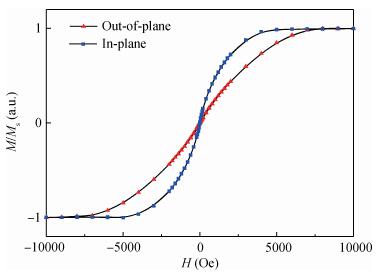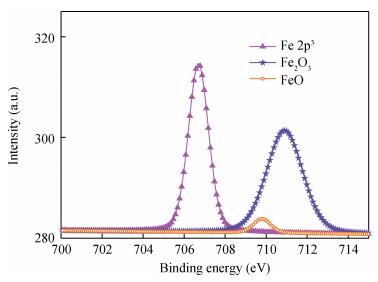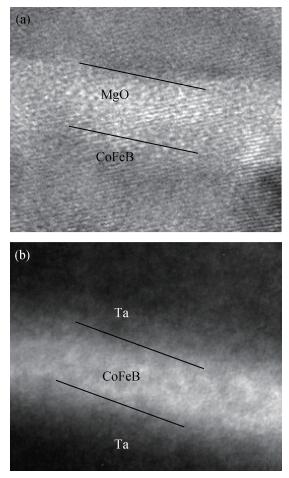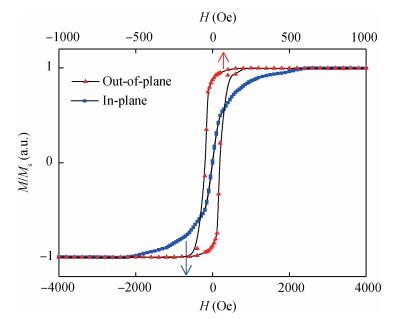| Citation: |
Yongle Lou, Yuming Zhang, Hui Guo, Daqing Xu, Yimen Zhang. Study on the mechanism of perpendicular magnetic anisotropy in Ta/CoFeB/MgO system[J]. Journal of Semiconductors, 2017, 38(6): 062003. doi: 10.1088/1674-4926/38/6/062003
****
Y L Lou, Y M Zhang, H Guo, D Q Xu, Y M Zhang. Study on the mechanism of perpendicular magnetic anisotropy in Ta/CoFeB/MgO system[J]. J. Semicond., 2017, 38(6): 062003. doi: 10.1088/1674-4926/38/6/062003.
|
Study on the mechanism of perpendicular magnetic anisotropy in Ta/CoFeB/MgO system
DOI: 10.1088/1674-4926/38/6/062003
More Information
-
Abstract
The mechanism of perpendicular magnetic anisotropy (PMA) in a MgO-based magnetic tunnel junction (MTJ) has been studied in this article. By comparing the magnetic properties and elementary composition analysis for different CoFeB-based structures, such as Ta/CoFeB/MgO, Ta/CoFeB/Ta and Ru/CoFeB/MgO structures, it is found that a certain amount of Fe-oxide existing at the interface of CoFeB/MgO is helpful to enhance the PMA and the PMA is originated from the interface of CoFeB/MgO. In addition, Ta film plays an important role to enhance the PMA in Ta/CoFeB/MgO structure. -
References
[1] Kent A D, Worledge D C. A new spin on magnetic memories. Nat Nanotechnol, 2015, 10(3):187 doi: 10.1038/nnano.2015.24[2] Matsukura F, Tokura Y, Ohno H. Control of magnetism by electric fields. Nat Nanotechnol, 2015, 10(3):209 doi: 10.1038/nnano.2015.22[3] Yu G Q, Upadhyaya P, Fan Y B, et al. Switching of perpendicular magnetization by spin-orbit torques in the absence of external magnetic fields. Nat Nanotechnol, 2014, 9(7):548 doi: 10.1038/nnano.2014.94[4] Brataas A, Kent A D, Ohno H. Current-induced torques in magnetic materials. Nat Mater, 2012, 11(5):372 doi: 10.1038/nmat3311[5] Wang W G, Li M, Hageman S, et al. Electric-field-assisted switching in magnetic tunnel junctions. Nat Mater, 2012, 11(1):64 http://www.nature.com/nmat/journal/v11/n1/fig_tab/nmat3171_F2.html[6] Qiu X P, Deorani P, Narayanapillai K, et al. Angular and temperature dependence of current induced spin-orbit effective fields in Ta/CoFeB/MgO nanowires. Sci Rep, 2014, 4(3):528 https://koreauniv.pure.elsevier.com/en/publications/angular-and-temperature-dependence-of-current-induced-spin-orbit-[7] Wang Z, Zhao W, Deng E, et al. Perpendicular-anisotropy magnetic tunnel junction switched by spin-Hall-assisted spin-transfer torque. J Phys D Appl Phys, 2015, 48(6):065001 doi: 10.1088/0022-3727/48/6/065001[8] Peng S Z, Wang M X, Yang H X, et al. Origin of interfacial perpendicular magnetic anisotropy in MgO/CoFe/metallic capping layer structures. Sci Rep, 2015, 5:18173 https://arxiv.org/pdf/1506.04078[9] Gottwald M, Kan J J, Lee K, et al. Scalable and thermally robust perpendicular magnetic tunnel junctions for STT-MRAM. Appl Phys Lett, 2015, 106(3):952 http://adsabs.harvard.edu/abs/2015ApPhL.106c2413G[10] Harnsoongnoen S, Surawanitkun C. Fast switching in thermoelectric spin-transfer torque MRAM with temperature increase caused by Peltier effect. Integr Ferroelectr, 2015, 165(1):98 doi: 10.1080/10584587.2015.1062703[11] Nishimura N, Hirai T, Koganei A, et al. Magnetic tunnel junction device with perpendicular magnetization films for high-density magnetic random access memory. J Appl Phys, 2002, 91(8):5246 doi: 10.1063/1.1459605[12] Ohmori H, Hatori T, Nakagawa S. Perpendicular magnetic tunnel junction with tunneling magnetoresistance ratio of 64% using MgO (100) barrier layer prepared at room temperature. J Appl Phys, 2008, 103(7):07A911 doi: 10.1063/1.2840016[13] Nakayama M, Kai T, Shimomura N, et al. Spin transfer switching in TbCoFe/CoFeB/MgO/CoFeB/TbCoFe magnetic tunnel junctions with perpendicular magnetic anisotropy. J Appl Phys, 2008, 103(7):07A710 https://www.researchgate.net/publication/234958693_Spin_transfer_switching_in_TbCoFeCoFeBMgOCoFeBTbCoFe_magnetic_tunnel_junctions_with_perpendicular_magnetic_anisotropy[14] Chiaramonti A N, Schreiber D K, Egelhoff W F, et al. Effects of annealing on local composition and electrical transport correlations in MgO-based magnetic tunnel junctions. Appl Phys Lett, 2008, 93(10):511 https://www.researchgate.net/profile/Ann_Chiaramonti/publication/234876750_Effects_of_annealing_on_local_composition_and_electrical_transport_correlations_in_MgO-based_magnetic_tunnel_junctions/links/55c8c77a08aea2d9bdc91c54.pdf?inViewer=true&disableCoverPage=true&origin=publication_detail[15] Rahman M T, Lyle A, Hu G, et al. High temperature annealing stability of magnetic properties in MgO-based perpendicular magnetic tunnel junction stacks with CoFeB polarizing layer. J Appl Phys, 2011, 109(7):07C709 https://www.researchgate.net/publication/234931894_High_temperature_annealing_stability_of_magnetic_properties_in_MgO-based_perpendicular_magnetic_tunnel_junction_stacks_with_CoFeB_polarizing_layer[16] Cheng T, Cheng C, Chern G. Perpendicular magnetic anisotropy induced by a cap layer in ultrathin MgO/CoFeB/Nb. J Appl Phys, 2012, 112(112):33910 https://www.researchgate.net/publication/257973015_Perpendicular_magnetic_anisotropy_induced_by_a_cap_layer_in_ultrathin_MgOCoFeBNb[17] Li X J, Jiang S L, Zhang J Y, et al. Enhanced post-annealing stability of perpendicular Ta/CoFeB/Mg/MgO multilayers by inhibiting Ta diffusion. Appl Surf Sci, 2016, 365:275 doi: 10.1016/j.apsusc.2016.01.032[18] Ikeda S, Miura K, Yamamoto H, et al. A perpendicular-anisotropy CoFeB/MgO magnetic tunnel junction. Nat Mater, 2010, 9(9):721 doi: 10.1038/nmat2804[19] Jung J H, Lim S H, Lee S R. Strong perpendicular magnetic anisotropy in thick CoFeB films sandwiched by Pd and MgO layers. Appl Phys Lett, 2010, 96(4):042503 doi: 10.1063/1.3299009[20] Wang W X, Yang Y, Naganuma H, et al. The perpendicular anisotropy of Co40Fe40B20 sandwiched between Ta and MgO layers and its application in CoFeB/MgO/CoFeB tunnel junction. Appl Phys Lett, 2011, 99(1):012502 doi: 10.1063/1.3605564[21] Fowley C, Decorde N, Oguz K, et al. Perpendicular magnetic anisotropy in CoFeB/Pd bilayers.IEEE Trans Magn, 2010, 46(6):2116 doi: 10.1109/TMAG.2010.2044374[22] Cheng C W, Feng W, Chern G, et al. Effect of cap layer thickness on the perpendicular magnetic anisotropy in top MgO/CoFeB/Ta structures. J Appl Phys, 2011, 110(110):033916 https://www.researchgate.net/publication/234962735_Effect_of_cap_layer_thickness_on_the_perpendicular_magnetic_anisotropy_in_top_MgOCoFeBTa_structures[23] Ma Q L, Iihama S, Kubota T, et al. Effect of Mg interlayer on perpendicular magnetic anisotropy of CoFeB films in MgO/Mg/CoFeB/Ta structure. Appl Phys Lett, 2012, 101(12):122414 doi: 10.1063/1.4754118[24] Shimabukuro R, Nakamura K, Akiyama T, et al. Electric field effects on magnetocrystalline anisotropy in ferromagnetic Fe monolayers. Physica E, 2010, 42(4):1014 doi: 10.1016/j.physe.2009.11.110[25] Read J C, Mather P G, Buhrman R A. X-ray photoemission study of CoFeB/MgO thin film bilayers. Appl Phys Lett, 2007, 90(13):132503 doi: 10.1063/1.2717091[26] Wang W G, Hageman S, Li M, et al. Rapid thermal annealing study of magnetoresistance and perpendicular anisotropy in mag-netic tunnel junctions based on MgO and CoFeB.Appl Phys Lett, 2011, 99(10):102502 doi: 10.1063/1.3634026[27] Worledge D C, Hu G, Abraham D W, et al. Spin torque switching of perpendicular Ta/CoFeB/MgO-based magnetic tunnel junctions. Appl Phys Lett, 2011, 98(2):022501 doi: 10.1063/1.3536482[28] Liu T, Cai J W, Sun L. Large enhanced perpendicular magnetic anisotropy in CoFeB/MgO system with the typical Ta buffer replaced by an Hf layer. AIP Adv, 2012, 2(3):413 http://www.oalib.com/paper/2423942[29] Zhu Y, Han N. Research on enhanced perpendicular magnetic anisotropy in CoFe/Pd bilayer structure. Acta Phys Sin, 2012, 61(16):167505 http://wulixb.iphy.ac.cn/EN/Y2012/V61/I16/0167505[30] Neudert A, McCord J. Dynamic anisotropy in amorphous CoZrTa films. J Appl Phys, 2004, 95(11):6595 doi: 10.1063/1.1667796[31] Ibusuki T, Miyajima T, Umehara S, et al. Lower-temperature crystallization of CoFeB in MgO magnetic tunnel junctions by using Ti capping layer. Appl Phys Lett, 2009, 94(6):062509 doi: 10.1063/1.3080208 -
Proportional views





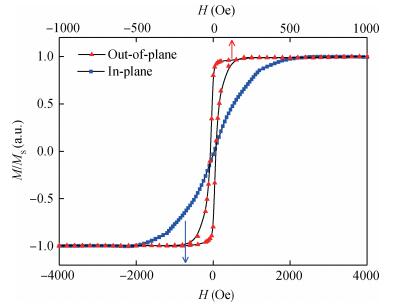
 DownLoad:
DownLoad:
